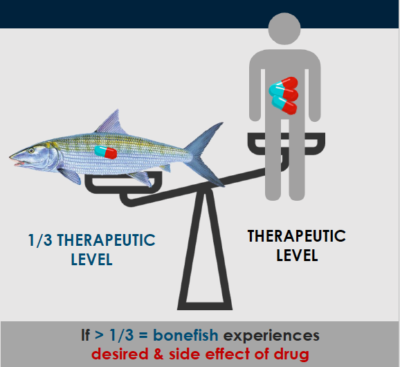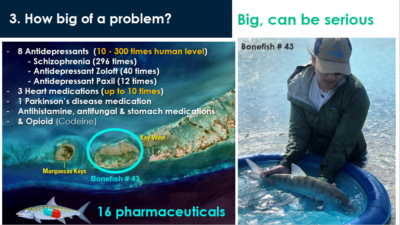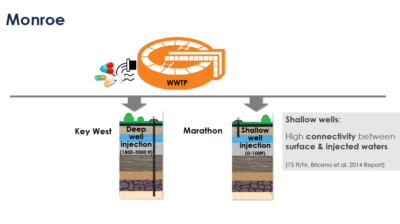Water Quality: Are Fish Addicted to Key West Drugs?
by Arnaud and Naja Girard…
A bonefish caught in the Lakes Passage just northwest of Key West harbor was found to have a schizophrenia drug in its bloodstream at a level 296 times the amount normally prescribed to a person. “It also had 8 anti-depressants at 10 to 300 times the human concentration,” says Florida International University (FIU) associate professor Dr. Jennifer Rehage. Two weeks ago Dr. Rehage and FIU PhD candidate Nick Castillo shared the staggering results of a three-year study of the impact of pharmaceuticals on bonefish in South Florida waters with members of Florida Bay Forever.
Their research, funded by Bonefish & Tarpon Trust, detected a total of 58 different drugs with an average of 7 pharmaceuticals per fish, and an astounding 17 pharmaceuticals in a single fish. The list includes antidepressants, prostate treatment medications, antibiotics, blood pressure medications, pain relievers and opioids. Researchers also found pharmaceuticals in bonefish prey — crabs, shrimp and toadfish — implicating a threat to Florida’s other fisheries, not only the bonefish fishery.
 Findings were not limited to just trace amounts. “We’re not only seeing that the fish have the pharmaceuticals,” says Dr. Rehage, “but half [56%] of them have a level of at least one pharmaceutical, many of them more than one, that exceeds one-third the concentration your doctor wants you to have in your bloodstream.” (Enough to give the fish similar effects as their human counterparts.)
Findings were not limited to just trace amounts. “We’re not only seeing that the fish have the pharmaceuticals,” says Dr. Rehage, “but half [56%] of them have a level of at least one pharmaceutical, many of them more than one, that exceeds one-third the concentration your doctor wants you to have in your bloodstream.” (Enough to give the fish similar effects as their human counterparts.)
Dry Tortugas National Park more polluted than Key West
The results of the bonefish pharmaceutical study are puzzling to say the least and might come as an embarrassment to some. In the area of the Dry Tortugas, a remote national park almost 70 miles west of Key West, 93% of fish tested above the ⅓ threshold while in fish sampled near densely populated Key West the ratio was only 27%. Another result was telling: The fish at the national park had Tylenol in their bloodstream.
“Tylenol is a great marker,” says Dr. Rehage, “Tylenol gets removed by conventional [wastewater] treatment that we have today, so if we find it, it means that it came directly from water that didn’t go through wastewater treatment. It could be a septic system. So, guess what? The fish in the Dry Tortugas have Tylenol,” says Dr. Rehage.
This means that somehow untreated or poorly treated sewage is finding its way into the park’s nearshore waters.
“We do share the concerns reported in FIU and the Bonefish Tarpon Trust study. At this stage, more studies are needed to understand the origin of this pharmaceutical contamination while taking into account the movement of fish and its prey base,” says Antonia Florio, spokesperson for the U.S. National Parks Service, in an email providing detailed information about how human waste is managed at the Dry Tortugas National Park.
Drug-addicted fish
 Some fish sampled from the same area had a much higher number of drugs at much higher concentrations than their immediate swim buddies.
Some fish sampled from the same area had a much higher number of drugs at much higher concentrations than their immediate swim buddies.
The star of the study is “Fish 43” – the most polluted fish – one caught off Key West in the Lakes Passage. It’s called Fish 43 because it’s one of 93 bonefish that were caught and tested during the study. Fish 43 was found to have 16 different pharmaceuticals in its bloodstream, many at jaw-dropping concentrations.
Why does that one fish have so much more drugs in its system than other fish that were caught swimming just beside it? According to Castillo one possibility is that Fish 43 has become a drug addict. Castillo, who is basing his PhD candidacy on the bonefish pharmaceutical study, worked alongside Dr. Rehage, catching, testing and analyzing the data. “They were all in the same flat, presumably from the same school. There’s recent research into whether or not fish become drug addicts. Trout given the ability to choose water with methamphetamines or clean water choose the methamphetamine water.”
Studies also show that fish have a higher mortality rate when they’re exposed to pharmaceuticals. “Fish exposed to antidepressants are more active. They are more bold. They take more risks. They move more, they explore more, they migrate faster, and they die faster because all of those behaviors are risky,” says Dr. Rehage.
Dangerously inefficient sewer systems
“One-half of the world’s drugs [6.3 billion prescriptions] are consumed by Americans. We’re not half the world’s people, but we consume half of the world’s drugs and in Florida we rank third. Fifty percent of the drugs we consume we excrete,” says Dr. Rehage.
How do all of those pharmaceuticals make their way into our nearshore waters and end up, in such large concentrations in fish? The answer is human sewage.
Most properties in the Florida Keys are currently linked to centralized sewer systems where sewage is treated before being injected into wells. But pharmaceuticals are not removed during the treatment process.
 In some parts of the Keys, like Marathon and Stock Island, the treated sewage is injected into shallow wells, just 60-90 feet below ground. “We know from studies of injected dyes into the water, that it comes back within hours. It travels 75 feet per hour. It comes right back up,” says Dr. Rehage.
In some parts of the Keys, like Marathon and Stock Island, the treated sewage is injected into shallow wells, just 60-90 feet below ground. “We know from studies of injected dyes into the water, that it comes back within hours. It travels 75 feet per hour. It comes right back up,” says Dr. Rehage.
A group of concerned citizens have filed a federal lawsuit to force the city of Marathon to abandon the use of shallow wells.
Other areas, like Key West, use deep wells, injecting water at depths of 2000-3000 feet but still have some aging and notoriously leaky sewer pipes, which purge into the nearshore waters before reaching the wastewater treatment plants.
See Related: The Case of the Mysterious Water Contamination
“We’re reaching a planetary boundary. We have way too many chemicals out there and we don’t know what they do. We’re making them, we’re releasing them, they’re getting out there. One way or another they’re going to get out and then we have no idea what they do,” says Dr. Rehage.
Deep injection wells, like the ones used in Key Largo, Cudjoe and Key West, have an estimated cost of between 4 and 6 million dollars (2018). Dr. Rehage points out that even water injected into deep wells could eventually mix with ocean waters. “We inject with a presumption that it stays where it’s injected. We inject it at 2000 to 3000 feet. But the reality is that we don’t monitor. We don’t know where it went.”
Some communities, including entire European countries like Sweden and Switzerland, are opting for a sustainability model, building purification systems that allow for near full reclamation and reuse of wastewater.
“The good news is that this can all be fixed,” says Dr. Rehage, “Our wastewater is too damaging and too valuable at the same time. We need to clean it up and re-use it.”
DID YOU LIKE THIS STORY?
HELP KEEP LOCAL INDEPENDENT JOURNALISM ALIVE…
TO MAKE A ONE-TIME VOLUNTARY CONTRIBUTION
Use PAYPAL or your Credit Card
by clicking on the button below:
[You will be sending money to Blue Pimpernel LLC [dba Key West The Newspaper]
NOTE: CONTRIBUTIONS ARE NOT TAX-DEDUCTABLE
![]() or if you have a PAYPAL account you can always use this link to send any amount you choose:
or if you have a PAYPAL account you can always use this link to send any amount you choose:
https://www.paypal.me/thebluepaper
or send check or money order made out to:



Going to be interesting when the analytical tests of the sperm whale found off mud key come out.
Great reporting Blue Paper!
Cutting edge investigative journalism has been absent for far too long from the mainstream media, which has been co-opted and hijacked by multi-national corporations and governments for political purposes.
While ideologues grab the headlines arguing the appropriate use of pronouns; our water supplies, oceans and food sources are being poisoned in a cannibalizing frenzy.
Such partisan idiocy at the altar of demagoguery. Looks like it will end rather soon, as our ignorant, divisive and hateful insecurities have perched themselves upon the tipping pillars of a declining civilization.
“The Blue Paper” and its creators have courageously fought an ongoing battle to shine a “light of truth” upon issues that will make or break us as a community, nation and/or civilization…
Not much interest here… Let’s watch “The View” and “Hannity”, while reading “The Miami Herald” and “The Key West Citizen”; and all will be well… Oh!!! Please forgive me, I forgot to mention Facebook, Social Media and Smartphones… My level of consciousness swirled upward and beyond at the mere mention of these fact finding and truth seeking devices…
Cowardice and indolence will starve our Spirits and rot our Minds..
.